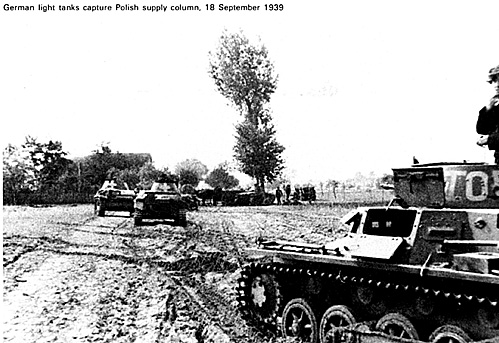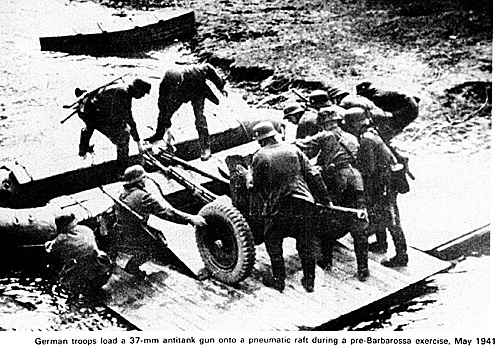 The campaigns in Poland and France provoked no changes to German defensive doctrine. If anything, operations during these spectacularly successful German offensives seemed to diminish the importance of defensive precautions. Skewered by German panzer thrusts, the Polish and French Armies succumbed without seriously testing German defensive measures in return.
The campaigns in Poland and France provoked no changes to German defensive doctrine. If anything, operations during these spectacularly successful German offensives seemed to diminish the importance of defensive precautions. Skewered by German panzer thrusts, the Polish and French Armies succumbed without seriously testing German defensive measures in return.
German light tanks capture Polish supply column, 18 September 1939
In each campaign, the Germans fought a small number of defensive engagements. Although the Germans learned some valuable tactical lessons, they were insufficient to spur a reevaluation of German defensive techniques.
After-action reports from the Polish campaign revealed a general dissatisfaction with training and small-unit leadership within the German Army. [66] Singled out for criticism were a number of reservist units that in their training and cohesion were not prepared for the rigors of the Elastic Defense. [67]
In October 1939, in an Army High Command memorandum detailing deficiencies uncovered in Poland, defensive operations was listed as an area in need of immediate improvement. This complaint, however, emphasized performance rather than doctrine. [68]
The campaign in France likewise was not without its defensive lessons. Most disquieting was the British tank attack at Arras on 21 May 1940. There, the rapidly advancing German panzers had become separated from their following infantry. Falling on the unsupported German infantry forces, the British armored attack illustrated not only the danger inherent in the de facto German policy of giving separate offensive and defensive roles to their tanks and infantry, but also the inadequacy of German antitank weaponry. Only the timely fire of German 88-mm flak guns and 105-mm field guns prevented the German infantry from being entirely overrun, as shells from the German 37-mm Paks and the even lighter antitank rifles rattled off the British Matildas without apparent effect. German tanks, hurriedly retracing their steps and returning to the scene, were also outgunned by both the British tanks and antitank guns.
The close call at Arras caused some ripples of concern within the German Army; however, this concern did not mature into reform. Although the German panzer and infantry forces had become perilously divided during the advance to the Channel -- a situation to be repeated on an even grander scale in Russia-neither the French nor the British had been able to exploit this vulnerability decisively.
The Germans, therefore, shrugged off the potential danger. A few new motorized infantry divisions were activated in the year between the fall of France and the invasion of Russia, but not nearly enough to provide
defensive security for the panzers or to take up the slack between the mobile units and the trudging infantry forces. Indeed, the Germans shortly reaffirmed the exclusively offensive role of their panzer divisions: a new panzer operations manual published in December 1940 devoted twenty-six pages to discussing attack techniques, but only two paragraphs discussed defense. [69]
More immediately disquieting was the woeful German antitank weaponry. Hitler ordered the punchless Panzer IIIs upgunned, an overhaul that was completed within the next year. [7]
The German Paks, however, could not be so easily replaced or repaired. Although some captured French 47-mm guns and a few new 50-mm Paks were introduced to augment the 37-mm antitank guns, the smaller (and virtually ineffective) weapons remained the primary dedicated crew-served antitank weapons of German infantry divisions at the beginning of Barbarossa. [71] As an interim precautionary measure, German field artillery units placed greater emphasis on close-range antitank engagements during training in the spring of 1941. [72]
Overview: German Doctrine on the Eve of Barbarossa
Before the beginning of Operation Barbarossa in 1941, the German Army adhered to a defensive doctrine originally developed to address battlefield conditions of World War I. Although temporarily shunted aside in the 1920s
during a faddish pursuit of offensive maneuver, the conservative defensive practices of 1918 had been reinstated in the German Army by the mid-1930s. This defensive doctrine concentrated on halting enemy infantry attacks by means of a defense in depth consisting of a series of defensive zones. Within these zones, enemy infantry forces were to be defeated
by firepower, tactical maneuver, and vigorous counterattack.
In the 1918 tradition, tanks were regarded as a lesser threat than enemy infantry. German antitank measures followed the 1918 outlines: enemy tanks would have their accompanying infantry stripped away; their advance would be obstructed by mines and obstacles; and a mixture of direct-fire artillery, antitank gunfire, and individual close assault would destroy those tanks that actually penetrated the German defensive positions. German tank units had no defensive role other than to deliver counterattacks where necessary to help crush enemy penetrations.
Whatever its potential faults, this doctrine suited the structure of the 1941 German armies. Its few panzer units aside, the Wehrmacht was as overwhelmingly pedestrian as had been the Imperial German Army of 1918. The Elastic Defense fit the skills, capabilities, and disposition of this preponderantly infantry-based force. On the eve of World War II, foreign
military observers correctly concluded that, with regard to defensive doctrine, the "German training manuals [showed] that the new German Army accepted the legacy of war-experience of its predecessors unreservedly." [73]
The German Elastic Defense doctrine made the following assumptions about
modern warfare, and they would be severely tested in the campaign against Russia.
None of these assumptions had been disproved in the 1939 or 1940 campaigns. However, within the first two years of the Russian campaign, the German Army conducted major defensive operations under circumstances that invalidated them all.
 German troops load a 37-mm antitank gun onto a pneumatic raft during a pre-Barbarossa exercise, May 1941
German troops load a 37-mm antitank gun onto a pneumatic raft during a pre-Barbarossa exercise, May 1941
Back to Table of Contents -- Combat Studies Research # 2
Back to Combat Studies Research List of Issues
Back to MagWeb Master Magazine List
© Copyright 2005 by Coalition Web, Inc.
This article appears in MagWeb.com (Magazine Web) on the Internet World Wide Web. Other articles from military history and related magazines are available at http://www.magweb.com